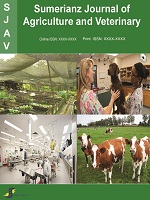Sumerianz Journal of Agriculture and Veterinary

Online ISSN: 2617-3077
Print ISSN: 2617-3131
Quarterly Published (4 Issues Per Year)
Journal Website: https://www.sumerianz.com/?ic=journal-home&journal=30Archive
Volume 5 Issue 2 (2022)
Effects of Soil Resistivity Variation with Depth on Crop Yield in a Typical Sedimentary Terrain, Igieduma-Edo State, Nigeria: A Geophysical Method Application in Agricultural Practice
Authors : Aigbedion I. ; Salufu S.O. ; ILUGBO STEPHEN OLUBUSOLA
DOI : doi.org/10.47752/sjav.52.34.43
Abstract:Accurate knowledge of soil fertility is required to promote global food security for life sustenance. Literatures have shown that electrical resistivity method is effective for agricultural site selection without passing through the rigor of soil test. However, the factor responsible for inconsistence in resistivity signature with soil fertility from one place to another, effect of soil texture and depth variation on crop yield are the questions this work geared at providing answers. Ten Vertical Electrical Sounding (VES) were conducted across the study area using Schlumberger array. Res1Dinvers was used for the inversion model, using Least Square method. Twenty soil samples were obtained in the VES points, two samples per point. One sample each at first and second layer. Result of the apparent resistivity showed that areas with high-excellent crop yield have resistivity signature above 500 Ωm while areas with low yield are characterized by values less than 500 Ωm. In both areas of low and high-excellent crop yield, the result of geochemical analysis indicated that Nitrogen, phosphate, and Potassium varied as 59-61%, 43-54mg/kg and 49-51mg/kg, respectively except for organic matter content that was above 3.8% in the first layer have high-excellent yield while low yield soil showed less than 3.8% in their first layer and even if the second layer’s organic matter is above 3.8%. This study has shown that organic matter has significant effect on soil resistivity signature than others soil nutrients (Phosphate, Potassium and Nitrogen). The study shows that soil’s first layer (0-0.3m) is the most suitable depth conducive for soil minerals occurrence for optimum agricultural output.
Antifungal In-Vitro Effects of Ethanol and Acetone Extracts of Aframomum Melequeta Lin. and (Azadirachta Indica Lin.) on Seedborne Fungal Pathogen (Fusarium Solani) of Sweet Pepper (Capsicum Annum Lin.) in Awka, Anambra State Nigeria
Authors : Iwuagwu C. C. ; Ezeh N. W. ; Nwogbaga A. C. ; Aguwa U. O. ; Iheaturu D. E. ; Ejiofor M. E.
DOI : doi.org/10.47752/sjav.52.20.33
Abstract:The use of plant extract in the control of seed borne fungal pathogen has been found to be economically and environmentally friendly and as well as easily biodegradable. This study was carried out to investigate the effect of plant extracts, Alligator pepper (Aframomum melegueta) and Neem (Azadirachta indica) on the seed borne fungal pathogen of sweet pepper Capsicum annum (Otuocha and Nsukka). Capsicum annum seeds were extracted for seed health test using blotter paper method. Seed borne fungal pathogen (Aspergillus spp. Fusarium spp.) were identified. The potential for these organisms for pathogenicity were tested using Kock’s postulate. The antifungal effects of ethanol and acetone extracts of the test plants were studied under in- vitro experiment against the seed borne fungal pathogen (Fusarium solani) of Capsicum annum at 0%, 50% and 75% concentration using synthetic fungicide (Benlate) as a standard control. The design was a 3x3 factorial laid out in a Completely Randomized Design (CRD) with three replications. Data collected were subjected to analysis of variance (ANOVA) and means were separated with Fishers’ Least Significant Difference (FLSD) at 5% probability level. Ninety percent germination was obtained in the viability test of Nsukka pepper. The result of the pathogenicity test showed that the organisms isolated were pathogenic. All plant extracts (Aframomum melegueta) and Neem (Azadirachta indica) and Benlate inhibited radial growth of the test fungus. Azadirachta indica and Benlate inhibited the growth of Fusarium solani for three days in culture, though Azadirachta indica performed better than Benlate. The inhibition was also greater as concentration increased from 50% to 75% concentration level. The result of this study showed that the plant extract Azadirachta indica, which is naturally more abundant and readily available could be explored as an eco-friendly alternative to synthetic fungicide (Benlate) in the control of Fusarium solani on sweet pepper varieties since it performed as much as the synthetic fungicide.



